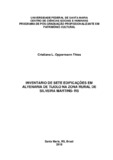| dc.creator | Thies, Cristiane Leticia Oppermann | |
| dc.date.accessioned | 2019-02-22T14:16:39Z | |
| dc.date.available | 2019-02-22T14:16:39Z | |
| dc.date.issued | 2018-09-17 | |
| dc.identifier.uri | http://repositorio.ufsm.br/handle/1/15721 | |
| dc.description.abstract | The valuation of cultural heritage makes it possible for a community to come into contact with its history. The built material patrimony is one of the most visible ways of maintaining points of recognition and understanding of the past history. Through measures like the inventory of buildings it is possible that the buildings are registered and valued. The region of Silveira Martins has a large built heritage of buildings from the time of the arrival of Italian immigrants, mostly in brick. In order to preserve part of this patrimony, the present study is an inventory of houses built in brick and without plastering in the rural area of Silveira Martins-RS in the period between 1877 and 1930. Seven buildings were inventoried, with the characteristics mentioned above and which will be compared to the lower floors of Italian houses in the Veneto and Belluno region of Italy, to see if they follow the same spatial configurations. For the cataloging of the buildings were used the inventory sheets used by IPHAE and the selection criteria were the construction typology and the absence of plastering to facilitate the visualization of the construction details. Bibliographic review, survey of buildings, measurements and redesign were carried out for subsequent analysis and interpretation and comparison of the results with the literature data. From these analyzes were made inventory records to record the results. As a conclusion, it is necessary to value and raise public awareness about this great built heritage that can contribute significantly to the development of the region | eng |
| dc.language | por | por |
| dc.publisher | Universidade Federal de Santa Maria | por |
| dc.rights | Attribution-NonCommercial-NoDerivatives 4.0 International | * |
| dc.rights.uri | http://creativecommons.org/licenses/by-nc-nd/4.0/ | * |
| dc.subject | Patrimônio cultural | por |
| dc.subject | Quarta Colônia de imigração italiana | por |
| dc.subject | Edificações de tijolo | por |
| dc.subject | Cultural heritage | eng |
| dc.subject | Forth colony of italian imigration | eng |
| dc.subject | Brink building | eng |
| dc.title | Inventário de sete edificações em alvenaria de tijolo na zona rural de Silveira Martins- RS | por |
| dc.title.alternative | Inventory of seven buildings in brick masonry in the rural area of Silveira Martins-RS | eng |
| dc.type | Dissertação | por |
| dc.description.resumo | A valorização do patrimônio cultural faz com que seja possível que uma comunidade entre em contato com a sua história. O patrimônio material edificado é uma das formas mais visíveis de manter pontos de reconhecimento e entendimento da história ali passada. Através de medidas como o inventário de edificações é possível que os edifícios sejam registrados e valorizados. A região de Silveira Martins tem um grande patrimônio edificado de construções da época da vinda dos imigrantes italianos, a maioria em tijolo. Como o intuito de preservar parte deste patrimônio, o presente estudo é um inventário de casas edificadas em tijolo e sem reboco na zona rural de Silveira Martins-RS no período compreendido entre 1877 e 1930. Foram inventariadas sete edificações, com as características acima citadas e que serão comparadas com as plantas baixas de casas italianas da região de Vêneto e Belluno na Itália, para verificar se seguem as mesmas configurações espaciais. Para a catalogação das edificações foram utilizadas as fichas de inventário e os critérios de seleção foram a tipologia construtiva e a ausência de reboco para facilitar a visualização dos detalhes construtivos. Foi realizada a revisão bibliográfica, pesquisa das edificações, medições e redesenho para posterior análise e interpretação e comparação dos resultados com os dados da literatura. A partir destas análises foram confeccionados fichas de inventários para registro dos resultados. Como conclusão, são necessárias valorizar e conscientizar a população sobre este grande patrimônio edificado que pode contribuir significativamente para o desenvolvimento da região. | por |
| dc.contributor.advisor1 | Saad, Denise de Souza | |
| dc.contributor.advisor1Lattes | http://lattes.cnpq.br/5104361169659851 | por |
| dc.contributor.advisor-co1 | Pereira, Clarissa de Oliveira | |
| dc.contributor.advisor-co1Lattes | http://lattes.cnpq.br/1952567883594336 | por |
| dc.contributor.referee1 | Lopes, Caryl Eduardo Jovanovich | |
| dc.contributor.referee1Lattes | http://lattes.cnpq.br/0701827238095286 | por |
| dc.contributor.referee2 | Rech, Roberta Paula | |
| dc.contributor.referee2Lattes | http://lattes.cnpq.br/3606921689620152 | por |
| dc.creator.Lattes | http://lattes.cnpq.br/2000305126340752 | por |
| dc.publisher.country | Brasil | por |
| dc.publisher.department | História | por |
| dc.publisher.initials | UFSM | por |
| dc.publisher.program | Programa de Pós-Graduação em Patrimônio Cultural | por |
| dc.subject.cnpq | CNPQ::CIENCIAS HUMANAS::HISTORIA | por |
| dc.publisher.unidade | Centro de Ciências Sociais e Humanas | por |



